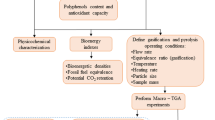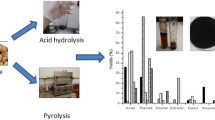Abstract
The thermal properties of artichoke waste, a relatively rich source of phenolic antioxidants, were investigated before and after phenolic recovery in order to assess its suitability as a source of bioproducts and bioenergy. The two main fractions of the waste, the bracts and the stems, were submitted to solvent extraction with aqueous ethanol (0, 50, 100% v/v) and the resulting extracts were assayed for total phenolics, flavonoids and antioxidant activity. The polyphenol content of stems was 51.10 ± 0.74 mg GAE/g and that of bracts was 24.58 ± 0.57 mg GAE/g. Using 50% aqueous ethanol provided the highest extraction yields, with over 80% of phenolic compounds recovered. The higher heating value of artichoke waste was about 16 MJ/kg and changed very little after polyphenol extraction. The ash content of the two waste fractions was close to 5% (w/w) and was further reduced upon phenolic recovery. The elemental ash composition for the two fractions was very similar: silicon was the most abundant element (> 40% w/w) followed by phosphorus, calcium and potassium. Finally, TGA/DTG analysis showed no significant differences in the thermal properties of the extracted and unextracted materials, suggesting the possibility of recovering phenolic antioxidants from artichoke waste and bioenergy from the extraction residue. This could provide economic advantages to the artichoke industry and reduce its environmental impact.





Similar content being viewed by others
References
Pandino, G., Lombardo, S., Mauromicale, G., Williamson, G.: Characterization of phenolic acids and flavonoids in leaves stems, bracts and edible parts of globe artichokes. Acta Hortic. 942, 413–417 (2012)
FAOSTAT: Food and agricultural commodities production. Final 2013 data, http://faostat3.fao.org/home/E (2013)
Gaafar, A.A., Salama, Z.A.: Phenolic compounds from artichoke (Cynara scolymus L.) byproducts and their antimicrobial activities. J. Biol. Agric. Healthc. 3(12), 1–7 (2013)
Santo Domingo, C., Soria, M., Rojas, A.M., Fissore, E.N., Gerschenson, L.N.: Protease and hemicellulase assisted extraction of dietary fiber from wastes of Cynara cardunculus. Int. J. Mol. Sci. 16, 6057–6075 (2015)
Machado, M.T.C., Ec, K.S., Vieira, G.S., Menegalli, F.C., Martínez, J., Hubinger, M.D.: Prebiotic oligosaccharides from artichoke industrial waste: evaluation of different extraction methods. Ind. Crop Prod. 76, 141–148 (2015)
Pandino, G., Lombardo, S., Mauromicale, G.: Globe artichoke leaves and floral stems as a source of bioactive compounds. Ind. Crop Prod. 44, 44–49 (2013)
Lattanzio, V., Kroon, P.A., Linsalata, V., Cardinali, A.: Globe artichoke: a functional food and source of nutraceutical ingredients. J. Funct. Food 1, 131–134 (2009)
Lombardo, S., Pandino, G., Mauromicale, G., Knödler, M., Carle, R., Schieber, A.: Influence of genotype, harvest time and plant part on polyphenolic composition of globe artichoke [Cynara cardunculus L. var. scolymus (L.) Fiori]. Food Chem. 119, 1175–1181 (2010)
Rouphael, Y., Bernardi, J., Cardarelli, M., Bernardo, L., Kane, D., Colla, G., Lucini, L.: Phenolic compounds and sesquiterpene lactones profile in leaves of nineteen artichoke cultivars. J. Agric. Food Chem. 16, 8540–8548 (2016)
Rouphael, Y., Colla, G., Graziani, G., Ritieni, A., Cardarelli, M., De Pascale, S.: Phenolic composition, antioxidant activity and mineral profile in two seed-propagated artichoke cultivars as affected by microbial inoculants and planting time. Food Chem. 234, 10–19 (2017)
Colla, G., Rouphael, Y., Cardarelli, M., Svecova, E., Rea, E., Lucini, L.: Effects of saline stress on mineral composition, phenolic acids and flavonoids in leaves of artichoke and cardoon genotypes grown in floating system. J. Sci. Food Agric. 93, 1119–1127 (2013)
Negro, D., Montesano, V., Grieco, S., Crupi, P., Sarli, G., De Lisi, A., Sonnante, G.: Polyphenol compounds in artichoke plant tissues and varieties. J. Food Sci. 77, C244–C252 (2012)
Kuczmannová, A., Gál, P., Varinská, L., Treml, J., Ková, I., Novotný, M., Vasilenko, T., Dall’Acqua, S., Nagy, M., Mucaji, P.: Agrimonia eupatoria L. and Cynara cardunculus L. water infusions: phenolic profile and comparison of antioxidant activities. Molecules 20, 20538–20550 (2015)
Afifi, N., Ramadan, A., Yassin, N.Z., Fayed, H.M., Abdel-Rahman, R.F.: Molecular mechanisms underlying hepatoprotective effect of artichoke extract: modulates TNF-induced activation of nuclear transcription factor (NF-Kappa β) and oxidative burst inhibition. World J. Pharm. Pharm. Sci. 4, 1546–1562 (2016)
Mohamed, S.H., Ahmed, H.H., Farrag, A.R.H., Abdel-Azim, N.S., Shahat, A.A.: Cynara scolymus for relieving on nonalcoholic steatohepatitis induced in rats. Int. J. Pharm. Pharm. Sci. 5, 57–66 (2013)
Chemat, F., Vian, M.A., Cravotto, G.: Green extraction of natural products: concept and principles. Int. J. Mol. Sci. 13, 8615–8627 (2012)
Zuorro, A.: Response surface methodology analysis of polyphenol recovery from artichoke waste. Am. J. Appl. Sci. 11, 1463–1471 (2014)
Zuorro, A., Maffei, G., Lavecchia, R.: Reuse potential of artichoke (Cynara scolimus L.) waste for the recovery of phenolic compounds and bioenergy. J. Clean. Prod. 111, 279–284 (2016)
Lavecchia, R., Zuorro, A.: Evaluation of olive pomace as a source of phenolic antioxidants for the production of functional cosmetics. Int. J. Appl. Eng. Res. 14, 34405–34409 (2015)
Zuorro, A., Lavecchia, R.: Spent coffee grounds as a valuable source of phenolic compounds and bioenergy. J. Clean. Prod. 34, 49–56 (2012)
Zhishen, J., Mengcheng, T., Jianming, W.: The determination of flavonoid contents in mulberry and their scavenging effects on superoxide radicals. Food Chem. 64, 555–559 (1999)
Brand-Williams, W., Cuvelier, M.E., Berset, C.: Use of a free radical method to evaluate antioxidant activity. LWT Food Sci. Technol. 28, 25–30 (1995)
Conde, E., Cara, C., Moure, A., Ruiz, E., Castro, E., Domínguez, H.: Antioxidant activity of the phenolic compounds released by hydrothermal treatments of olive tree pruning. Food Chem 114, 806–812 (2009)
Fiore, V., Valenza, A., Di Bella, G.: Artichoke (Cynara cardunculus L.) fibres as potential reinforcement of composite structures. Compos. Sci. Technol. 71, 1138–1144 (2011)
Peres, R.S., Armelin, E., Alemán, C., Ferreira, C.A.: Modified tannin extracted from black wattle tree as an environmentally friendly antifouling pigment. Ind. Crop Prod. 65, 506–514 (2015)
Cheng, D., Jiang, S., Zhang, Q.: Effect of hydrothermal treatment with different aqueous solutions on the mold resistance of bamboo with chemical and FTIR analysis. Bioresources 8(1), 371–382 (2013)
Kyraleou, M., Pappas, C., Voskidi, E., Kotseridis, Y., Basalekou, M., Tarantilis, P.A., Kallithraka, S.: Diffuse reflectance Fourier transform infrared spectroscopy for simultaneous quantification of total phenolics and condensed tannins contained in grape seeds. Ind. Crop Prod. 74, 784–791 (2015)
Liang, N., Lu, X., Hu, Y., Kitts, D.D.: Application of attenuated total reflectance-Fourier transformed infrared (ATR-FTIR) spectroscopy to determine the chlorogenic acid isomer profile and antioxidant capacity of coffee beans. J. Agric. Food Chem. 64, 681–689 (2016)
Tortosa Masiá, A.A., Buhre, B.J.P., Gupta, R.P., Wall, T.F.: Characterising ash of biomass and waste. Fuel Process. Technol. 88, 1071–1081 (2007)
García, R., Pizarro, C., Lavín, A.G., Bueno, J.L.: Characterization of Spanish biomass wastes for energy use. Biorersour. Technol. 103, 249–258 (2012)
Lutz, M., Henriquez, C., Escobar, R.: Chemical composition and antioxidant properties of mature and baby artichokes (Cynara scolymus L.), raw and cooked. J. Food Compos. Anal. 24, 49–54 (2011)
Ledda, L., Deligios, P.A., Farci, R., Sulas, L.: Biomass supply for energetic purposes from some Cardueae species grown in Mediterranean farming systems. Ind. Crop Prod. 47, 218–226 (2013)
Mackenzie, R.C.: Differential thermal analysis, vol. 2. Academic press, New York (1972)
Zuorro, A., Maffei, G., Lavecchia, R.: Effect of solvent type and extraction conditions on the recovery of phenolic compounds from artichoke waste. Chem. Eng. Trans. 39, 463–468 (2014)
Pandino, G., Lombardo, S., Mauromicale, G., Williamson, G.: Profile of polyphenols and phenolic acids in bracts and receptacles of globe artichoke (Cynara cardunculus var. scolymus) germplasm. J. Food Compos. Anal. 24, 148–153 (2011)
Dabbou, S., Dabbou, S., Flamini, G., Pandino, G., Gasco, L., Helal, A.N.: Phytochemical compounds from the crop byproducts of Tunisian globe artichoke cultivars. Chem. Biodivers. 13, 1475–1483 (2016)
Zuorro, A.: Optimization of polyphenol recovery from espresso coffee residues using factorial design and response surface methodology. Sep. Purif. Technol. 152, 64–69 (2015)
Damartzis, T., Vamvuka, D., Sfakiotakis, S., Zabaniotou, A.: Thermal degradation studies and kinetic modeling of cardoon (Cynara cardunculus) pyrolysis using thermogravimetric analysis (TGA). Bioresour. Technol. 102, 6230–6238 (2011)
Femenia, A., Robertson, J.A., Waldron, K.W., Selvendran, R.R.: Cauliflower (Brassica oleracea L.), globe artichoke (Cynara scolymus) and chicory witloof (Cichorium intybus) processing by-products as sources of dietary fibre. J. Sci. Food Agric. 77, 511–518 (1998)
Meng, A., Chen, S., Long, Y., Zhou, H., Zhang, Y., Li, Q.: Pyrolysis and gasification of typical components in wastes with macro-TGA. Waste Manage. 46, 247–256 (2015)
Doshi, P., Srivastava, G., Pathak, G., Dikshit, M.: Physicochemical and thermal characterization of nonedible oilseed residual waste as sustainable solid biofuel. Waste Manage. 34, 1836–1846 (2014)
Vamvuka, D., Sfakiotakis, S.: Combustion behavior of biomass fuels and their blends with lignite. Thermochim. Acta 526, 192–199 (2011)
Wildschut, J., Smit, A.T., Reith, J.H., Huijgen, W.J.J.: Ethanol-based organosolv fractionation of wheat straw for the production of lignin and enzymatically digestible cellulose. Bioresour. Technol. 135, 58–66 (2013)
Saidur, R., Abdelaziz, E.A., Demirbas, A., Hossain, M.S., Mekhilef, S.: A review on biomass as a fuel for boilers. Renew. Sust. Energ. Rev. 15, 2262–2289 (2011)
Nzihou, A., Stanmore, B.R.: The formation of aerosols during the co-combustion of coal and biomass. Waste Biomass Valor. 6, 947–957 (2015)
Author information
Authors and Affiliations
Corresponding author
Rights and permissions
About this article
Cite this article
Lavecchia, R., Maffei, G., Paccassoni, F. et al. Artichoke Waste as a Source of Phenolic Antioxidants and Bioenergy. Waste Biomass Valor 10, 2975–2984 (2019). https://doi.org/10.1007/s12649-018-0305-y
Received:
Accepted:
Published:
Issue Date:
DOI: https://doi.org/10.1007/s12649-018-0305-y




